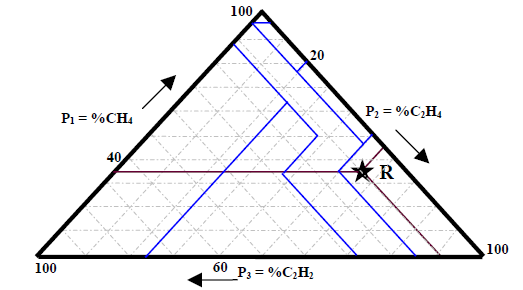

Duval, M.Transformer oil sample analysis is a useful, predictive, maintenance tool for determining transformer health.Duval, M., “A Review of Faults Detectable by Gas-in-oil Analysis in Transformers,” IEEE Electrical Insulation Magazine, Vol.Enter the oil sample under “Sample 5” to get the diagnosis. Use the following link to the “Analysis”section to get the Duvals Triangle 1 diagnosis of the oil samples. Duval’s Triangle 5 is composed of the gases CH 4, C 2H 4, and C 2H 6 which is formed more specifically for the identification of faults of high temperature to ascertain more information about thermal faults in paper and oil. In an updated version, Duval’s Triangle 4 is composed of the three gases H2, CH4, and C2H6 which are more specific for low energy or temperature (PD, T1, and T2). The Low Energy Degradation Triangle (LEDT) method however can provide a trend from Normal operation to a developing fault.

Thus this method is not as effective in identifying a change from a normal state to a defective state. One of the key challenges of this method is that there is no region in the triangle to indicate a normal aging state for the transformer. The conditions identified are Partial Discharges (PD), Discharges of Low Energy (D1), Discharges of High Energy (D2), Thermal Faults of temperature 700☌, and Thermal Faults of temperature > 700☌ (T3). The Duval Triangle 1 is very useful in providing diagnoses when a fault condition is already identified due to the fact that two of the three gases used (ethylene and acetylene) are products of high-energy conditions. Figure 1 presents the triangle with the definition of the seven fault diagnosis regions. The triangle has a clockwise direction in terms of increasing percentage gas levels. Each point is derived from the percentage volume of the sum of the three gases. The triangle is able to differentiate the fault types partial discharges, electrical faults (high and low energy arcing), and thermal faults (hot spots of various temperature ranges). The Duval Triangle 1 Method makes use of the three combustible gases Methane (CH 4), Ethylene (C 2H 4), and Acetylene (C 2H 2) which are transformed for representation in a triangular plot.


 0 kommentar(er)
0 kommentar(er)
